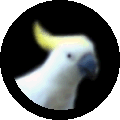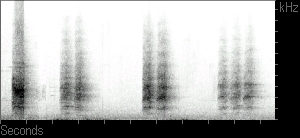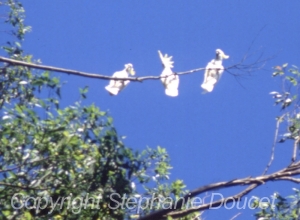 Sulphur-crested
Cockatoo
Sulphur-crested
Cockatoo Cacatua galerita
 Figure 1. Spectrogram of the
Sulphur-crested Cockatoo call.
(The first 10-seconds from the sound file are depicted.)
Figure 1. Spectrogram of the
Sulphur-crested Cockatoo call.
(The first 10-seconds from the sound file are depicted.)
Sulphur-crested Cockatoo - Cacatua galerita
There are two extraordinary aspects of sulphur-crested cockatoo behaviour. The first is the awesome volume of the sulphur-crested cockatoo's call. Sitting quietly in the Atherton rainforests, waiting to record the sounds of the more timid birds, I was often scared out of my wits when a sulphur-crested cockatoo began screaming in the canopy high above me. After three weeks in the Atherton rainforests I had still not grown accustomed to this vocalization, and I still jumped each time I heard one of these impressive birds scream. The volume of these birds' calls must pose an obstacle for all other animals who try to communicate using the same airspace; even from their songposts high in the canopy, the sulphur-crested cockatoo’s calls mask the vocalizations of birds on the forest floor.
The second extraordinary aspect of sulphur-crested cockatoo behaviour is the tremendous distances these social animals cover in their daily routine. I have seen noisy flocks of more than fifty cockatoos fly from one forested mountaintop to another. I have heard these birds travel the canopy alighting in the valleys and peaks that form the landscape above the Atherton rainforest canopy. Clearly sulphur-crested cockatoos are animals that do not belong as isolated individuals confined to bird cages or pet stores.
An intriguing recent analysis of sulphur-crested cockatoo vocalizations found that the calls of these birds appear to be governed by fundamentally different processes than the songs of other birds. Whereas most bird vocalizations are composed of pure whistled notes or layers of harmonic sounds, sulfur-crested cockatoo vocalizations appear to have chaotic, non-harmonic properties. Chaotic acoustic structures also appear in the vocalizations of Australia’s gang-gang cockatoos, Callocephalon fimbriatum, and zebra finches, Taeniopygia guttata .
Habitat.
Sulphur-crested cockatoos occupy a wide variety of habitats, and appear to be equally adept at finding food in the heart of rainforests as in grassy fields next to beachside cabanas
Range.
Sulphur-crested cockatoos can be found in many parts of Australia, especially in the coastal areas of northern and eastern Australia, Papua New Guinea, and New Zealand.
Further Reading.
M. S. Fee, B. Shraiman, B. Pesaran, & P. P. Mitra. 1999. The role of nonlinear dynamics of the surinx in the vocalizations of a songbird. Nature. 395:67-71.
N. H. Fletcher. 2000. A class of chaotic bird calls? Journal of the Acoustical Society of America. 108:821-826.
No recordings, photographs, or other information may be used without permission (email me at: dmennill AT uwindsor DOT ca).